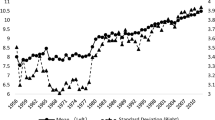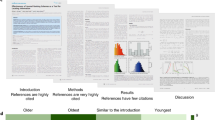Abstract
What makes a “good” title for an article, i.e. one which might attract citations in the academic community? Answers to this question are manifold, though inconclusive across disciplines. In an attempt to provide cohesion, we integrate significant title characteristics from previous studies across disciplines into a comprehensive model and link it with citation count. Keeping the application context constant, we focus on management science and find that only non-alpha numeric characters and a balanced title structure have small, but significant effects on citation count. Surprisingly, attributes which tended to show significant effects in other disciplines (though often in opposite directions), such as length, context, and linguistic attributes exhibited no relationship with citation count.

Similar content being viewed by others
Notes
We would like to thank one of the reviewers for alerting us to the link between downloads and citations.
We thank the reviewers for pointing this out.
References
Adam, D. (2002). Citation analysis: The counting house. Nature, 415(6873), 726–729.
Adler, N. J., & Harzing, A. W. (2009). When knowledge wins: Transcending the sense and nonsense of academic rankings. Academy of Management Learning and Education, 8(1), 72–95.
Aguinis, H., Suárez-González, I., Lannelongue, G., & Joo, H. (2012). Scholarly impact revisited. The Academy of Management Perspectives, 26(2), 105–132.
Aleixandre-Benavent, R., Montalt-Resurecció, V., & Valderrama-Zurián, J. C. (2014). A descriptive study of inaccuracy in article titles on bibliometrics published in biomedical journals. Scientometrics, 101(1), 781–791.
Anthony, L. (2001). Characteristic features of research article titles in computer science. Professional Communication on IEEE Transactions, 44(3), 187–194.
Ball, R. (2009). Scholarly communication in transition: The use of question marks in the titles of scientific articles in medicine, life sciences and physics 1966–2005. Scientometrics, 79(3), 667–679.
Bergh, D. D., Perry, J., & Hanke, R. (2006). Some predictors of SMJ article impact. Strategic Management Journal, 27(1), 81–100.
Buter, R. K., & van Raan, A. F. (2011). Non-alphanumeric characters in titles of scientific publications: An analysis of their occurrence and correlation with citation impact. Journal of Informetrics, 5(4), 608–617.
Cohen, J. (1992). A power primer. Psychological Bulletin, 112(1), 155.
Cole, J. R., & Cole, S. (1972). The Ortega Hypothesis Citation analysis suggests that only a few scientists contribute to scientific progress. Science, 178(4059), 368–375.
Conlon, D. E., Morgeson, F. P., McNamara, G., Wiseman, R. M., & Skilton, P. F. (2006). Examining the impact and role of special issue and regular journal articles in the field of management. Academy of Management Journal, 49(5), 857–872.
Diener, R. A. (1984). Informational dynamics of journal article titles. Journal of the American Society for Information Science, 35(4), 222–227.
Dillon, J. T. (1982). In pursuit of the colon: A century of scholarly progress: 1880–1980. The Journal of Higher Education, 53(1), 93–99.
Ferguson, T. D., & Ketchen, J. D. J. (1999). Organizational configurations and performance: The role of statistical power in extant research. Strategic Management Journal, 20(4), 385–395.
Fox, C. W., & Burns, C. S. (2015). The relationship between manuscript title structure and success: Editorial decisions and citation performance for an ecological journal. Ecology and Evolution, 5(10), 1970–1980.
Garfield, E. (2006). The history and meaning of the journal impact factor. JAMA, 295(1), 90–93.
Gibbert, M., & Ruigrok, W. (2010). The ‘‘what’’ and ‘‘how’’ of case study rigor: Three strategies based on published work. Organizational Research Methods, 13(4), 710–737.
Gilbert, G. N. (1977). Referencing as persuasion. Social Studies of Science, 7(1), 113–122.
Gomez-Mejia, L. R., & Balkin, D. B. (1992). Determinants of faculty pay: An agency theory perspective. Academy of Management Journal, 35(5), 921–955.
Habibzadeh, F., & Yadollahie, M. (2010). Are shorter article titles more attractive for citations? Crosssectional study of 22 scientific journals. Croatian Medical Journal, 51(2), 165–170.
Hartley, J. (2005). To attract or to inform: What are titles for? Journal of Technical Writing and Communication, 35(2), 203–213.
Hartley, J. (2007a). Colonic titles. Journal of the European Medical Writers Association, 16(4), 147–149.
Hartley, J. (2007b). Planning that title: Practices and preferences for titles with colons in academic articles. Library and Information Science Research, 29(4), 553–568.
Jacques, T. S., & Sebire, N. J. (2010). The impact of article titles on citation hits: An analysis of general and specialist medical journals. JRSM Short Reports, 1(1), 2.
Jacsó, P. (2006). Dubious hit counts and cuckoo’s eggs. Online Information Review, 30(2), 188–193.
Jakobovits, L. A., & Nahl-Jakobovits, D. (1987). Learning the library: Taxonomy of skills and errors. College and Research Libraries, 48(3), 203–214.
Jamali, H. R., & Nikzad, M. (2011). Article title type and its relation with the number of downloads and citations. Scientometrics, 88(2), 653–661.
James, L. R., Demaree, R. G., & Wolf, G. (1993). r wg: An assessment of within-group interrater agreement. Journal of Applied Psychology, 78(2), 306–309.
Judge, T. A., Cable, D. M., Colbert, A. E., & Rynes, S. L. (2007). What causes a management article to be cited-article author, or journal? Academy of Management Journal, 50(3), 491–506.
Laband, D. N. (1986). Article popularity. Economic Inquiry, 24(January), 173–180.
Leung, K. (2007). The glory and tyranny of citation impact: An East Asian perspective. Academy of Management Journal, 50(3), 510–513.
Lewison, G., & Hartley, J. (2005). What’s in a title? Numbers of words and the presence of colons. Scientometrics, 63(2), 341–356.
Lewison, G., & Paraje, G. (2004). The classification of biomedical journals by research level. Scientometrics, 60(2), 145–157.
Mabe, M. A., & Amin, M. (2002). Dr. Jekyll and Mr. Hyde: Author-reader asymmetries in scholarly publishing. ASLIB Proceedings, 54(3), 149–157.
Meho, L. I., & Yang, K. (2007). Impact of data sources on citation counts and rankings of LIS faculty: Web of Science versus Scopus and Google Scholar. Journal of the American Society for Information Science and Technology, 58(13), 2105–2125.
Michelson, G. (1994). Use of colons in titles and journal status in industrial relations journals. Psychological Reports, 74(2), 657–658.
Mingers, J., & Xu, F. (2010). The drivers of citations in management science journals. European Journal of Operational Research, 205(2), 422–430.
Moore, A. (2010). What’s in a title? A two-step approach to optimisation for man and machine. Bioessays, 32(3), 183–184.
Nagano, R. L. (2015). Research article titles and disciplinary conventions: A corpus study of eight disciplines. Journal of Academic Writing, 5(1), 133–144.
Newman, J. M., & Cooper, E. (1993). Determinants of academic recognition: The case of the journal of applied psychology. Journal of Applied Psychology, 78, 518–526.
Paiva, C. E., Lima, J. P. D. S. N., & Paiva, B. S. R. (2012). Articles with short titles describing the results are cited more often. Clinics, 67(5), 509–513.
Podsakoff, P. M., Mackenzie, S. B., Bachrach, D. G., & Podsakoff, N. P. (2005). The influence of management journals in the 1980s and 1990s. Strategic Management Journal, 26(5), 473–488.
Rostami, F., Mohammadpoorasl, A., & Hajizadeh, M. (2014). The effect of characteristics of title on citation rates of articles. Scientometrics, 98(3), 2007–2010.
Sagi, I., & Yechiam, E. (2008). Amusing titles in scientific journals and article citation. Journal of Information Science, 34(5), 680–687.
Siggelkow, N. (2001). Who reads my paper anyways? A survey of the journal readership and reputation. Working paper, The Wharton School, University of Pennsylvania.
Soler, V. (2007). Writing titles in science: An exploratory study. English for Specific Purposes, 26(1), 90–102.
Soler, V. (2011). Comparative and contrastive observations on scientific titles written in English and Spanish. English for Specific Purposes, 30(2), 124–137.
Stremersch, S., Verniers, I., & Verhoef, P. C. (2007). The quest for citations: Drivers of article impact. Journal of Marketing, 71(3), 171–193.
Subotic, S., & Mukherjee, B. (2014). Short and amusing: The relationship between title characteristics, downloads, and citations in psychology articles. Journal of Information Science, 40(1), 115–124.
Swales, J., & Feak, C. B. (1994). Academic writing for graduate students. A course for nonnative speakers of English. Ann Arbor, MI: The University of Michigan Press.
Tahai, A., & Meyer, M. J. (1999). A revealed preference study of management journals’ direct influences. Strategic Management Journal, 20(3), 279–296.
Van Wesel, M., Wyatt, S., & ten Haaf, J. (2014). What a difference a colon makes: How superficial factors influence subsequent citation. Scientometrics, 98(3), 1601–1615.
Walters, G. D. (2011). The citation life cycle of articles published in 13 American psychological association journals: A 25-year longitudinal analysis. Journal of the American Society for Information Science and Technology, 62(8), 1629–1636.
Whissell, C. (2012). The trend toward more attractive and informative titles: American Psychologist 1946–2010 1. Psychological Reports, 110(2), 427–444.
Yitzhaki, M. (2002). Relation of the title length of a journal article to the length of the article. Scientometrics, 54(3), 435–447.
Acknowledgments
The authors would like to thank Dr. Matthias Weiss (Ludwig-Maximilians-Universität München), and Mr. Simon Pek (Simon Fraser University) for their helpful comments. We would also like to thank both anonymous reviewers, as well as the Scientometrics editor Wolfgang Glaenzel for the excellent—challenging, yet always constructive feedback which they generously provided.
Author information
Authors and Affiliations
Corresponding author
Rights and permissions
About this article
Cite this article
Nair, L.B., Gibbert, M. What makes a ‘good’ title and (how) does it matter for citations? A review and general model of article title attributes in management science. Scientometrics 107, 1331–1359 (2016). https://doi.org/10.1007/s11192-016-1937-y
Received:
Published:
Issue Date:
DOI: https://doi.org/10.1007/s11192-016-1937-y




